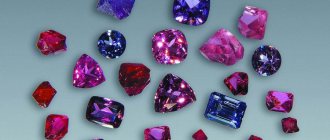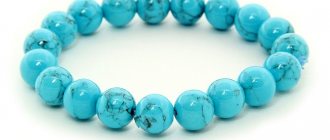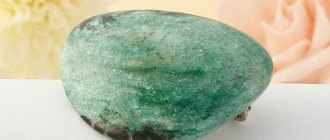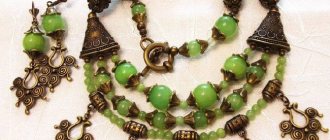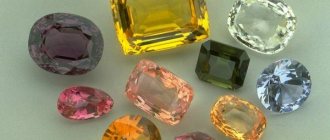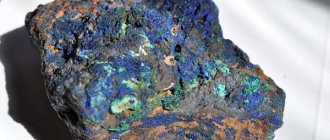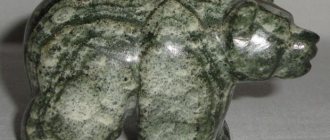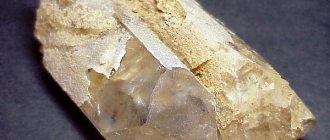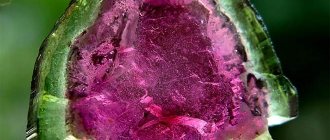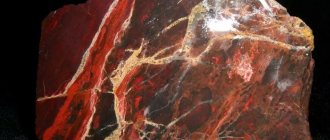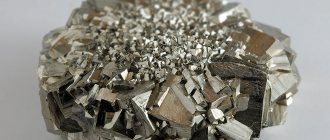Spinel is a rare mineral with an intriguing biography and magical properties. The prosaic name of the nugget - “magnesium aluminate” - does not fit in with its amazing beauty. It is as perfect as a ruby or sapphire, only less well known.
For countless centuries, this magnificent crystal has been treated as the “royal stone”. Many royal families, as well as mineral collectors and jewelry lovers, sought to add rare gems to their jewelry collections.
Historical reference
The famous traveler Marco Polo, who visited the Pamirs in the 13th century, first mentioned spinel as a jewelry stone. Spinel began to be mined in the 9th century in the southwest of the Pamirs in the Kuhilale deposit.
The stone was then often confused with ruby and corundum, so Marco Polo called the spinel deposit “ruby mines.”
With the development of science, the stone was identified as a separate group of minerals with unique physical properties. Despite this, spinel was often used in ancient times. It has always been one of the rarest and most expensive minerals.
The stone served as decoration and a symbol of power for representatives of Germany, Great Britain, Russia, and France:
- The famous “Monomakh's Cap” is decorated with spinel, and not with rubies, as was previously believed.
- The crown of Catherine the Great is inlaid with this stone.
- The Wittelbach Crown was decorated in 1830 with teardrop-shaped spinels. Previously it was assumed that these were rubies.
- The stone has had different names over the centuries of its existence: coelonite, noble spinel, picotite, lal, rubicel.
Origin of the stone
Our stone was proudly displayed on the crown of the Russian Empire.
Spinel is a stone whose name came to us from the German language. There are two versions about the origin of this term, common in Germany. The first is that it is derived from the Latin “spina” - thorn, while the second is from the Greek language, where “spinos” means “shine”.
The mineral has been mined in the Pamir Mountains since the ninth century. In the thirteenth century, the famous traveler Marco Polo visited these regions. He spoke about the “ruby mines” of the Mongol khans who then ruled this country. At the same time, the Italian called the spinel “lal”. This term, originating from Farsi, was used by the inhabitants of Asia in the Middle Ages to name all red precious stones, without singling out, for example, rubies or garnets.
The legends and fairy tales of the Pamir peoples still tell about the wars that powerful rulers started, wanting to get the coveted “lal”. With the development of jewelry, closer to the 18th century, Asian jewelers began to classify garnets and other red stones as a separate category. But they continued to confuse spinel with ruby.
They did not see the difference between the two stones in Europe either. Everything changed only in the middle of the 19th century, when chromatography and spectral analysis technologies were developed. It was then that it turned out that the crowns of the two greatest empires of the continent - Russian and British - had spinel instead of ruby.
After such an “exposure”, the gem was studied in detail, allocating a separate place for it among precious crystals - lower in value than a ruby, but higher than a garnet. Thus, the previously rarely used German term “spinel” entered all classifications of stones.
Mining locations
Large (5x3.5x3.2cm) octahedral crystal of dark blue spinel on marble.
Mogok, Mandalay, Burma From time immemorial, the mineral spinel was mined in the Pamirs. It was here that a record stone sample was discovered in 1985 - a crystal weighing more than five kilograms. This happened in the Kuhi-Lal (Ruby Mountain) deposit in the territory of then Soviet Tajikistan. In the Russian Federation, gem mining is carried out in the Republic of Yakutia, as well as in Altai and south of Lake Baikal.
The leaders in supplying the mineral to the world market are:
- Sri Lanka;
- India;
- Thailand;
- Afghanistan;
- Myanmar;
- Australia.
Almost everywhere it accompanies ruby deposits, which added even more confusion before the invention of chromatography. The most beautiful and expensive spinel specimens are mined in Myanmar. Sri Lanka boasts unique blue stones. Australian deposits are quite rich, but the crystals there are black and are used mainly for decoration or industrial purposes; their price is low.
Place of Birth
Most of the specimens of this mineral are of no value to mineralogists, and some are suitable due to their characteristics for industrial purposes.
Crystals of noble spinel, suitable for jewelry, are usually small in size - 10-12 carats (about 2 grams) .
The largest single crystal of pink spinel was found in Badakhshan (Tajikistan). The weight of this lala is 5.885 kg .
Only thanks to geologist Ya. A. Gurevich, who carefully processed a suspicious area in the adit and peeled out this unique nugget, the miracle crystal was not destroyed during blasting.
Spinel is mined in Austria, Afghanistan, India, and Madagascar.
The largest deposits are located in Myanmar, Sri Lanka, Thailand, and Cambodia.
It is noteworthy that in each country stones of certain shades are mined. For example, in Australia, black spinel is mainly mined; blue crystals are often found in Sri Lanka.
In Russia (in the Urals) green and blue spinel are mined.
Red spinel is a very rare and most valuable species. It is mined in Myenma (Mogok deposit) and in the Pamirs (Tajik Kuhilal deposit). The red variety is often accompanied by rubies in deposits. They are mined together to avoid future errors in identification. After cutting, these gems can only be distinguished using special equipment.
Physical and chemical properties
MgAl2O4 - spinel has a high degree of isomorphism of the metals it contains: some of the magnesium and aluminum ions can be replaced by metal ions of comparable size without changing the basic properties.
Magnesium ions are replaced by iron, sometimes zinc, and some of the aluminum is replaced by iron or chromium. Without affecting the basic properties in any way, this determines the color of the mineral.
| Formula | MgAl2O4 |
| Color | Colorless, red, pink, blue, green, purple, yellow |
| Shine | Glass |
| Transparency | Transparent to translucent |
| Hardness | 7,5—8 |
| Cleavage | Imperfect |
| Kink | Conchoidal |
| Density | 3.57—3.72 g/cm³ |
Spinel varieties
Among the very diverse varieties of spinel are:
- Noble spinel - transparent spinel crystals, painted in beautiful colors (if thick red - then they call it ruby spinel, if orange-red - rubicell, if pink - ruby-bale, if purple - oriental amethyst), also noble spinel can be called blue spinel ( or sapphire-spinel), alexandrite-effect spinel (blue in daylight, purple-violet in incandescent light), and blue and green spinel. The main deposits of noble spinel are the islands of Ceylon, Borneo, and India. Along with ruby, noble pink spinel is mined at the high-mountain Kugelal (Kuh-i-lal) deposit (Pamir, Tajikistan).
Rubicell
- Ordinary spinel, pleonast or ceylonite - spinel of intermediate composition between spinel itself and hercynite - (Mg,Fe)Al2O4. Specific gravity 3.7 - 4.4. Microhardness 1.666 - 1.765 at a load of 100 g. Color dark green to black, less often blue-black and dark brown. Melting point 1275-1360 °C. Decomposes from the action of HF and H2SO4. Occurs frequently, sometimes in very large crystals. In Russia there are many pleonastas in the Urals, in the Shishim and Nazyam mountains.
Pleonastus
- Chrome spinel - picotite, black, part of the aluminum is replaced by chromium.
Picotite
- Ganit is a zinc spinel where magnesium is replaced by iron and zinc.
Ganit
- Chlorine spinel - Mg(Al,Fe)2O4, intermediate between spinel and magnesioferrite; the color is bright green.
Chlorspinel
- Automolite is intermediate between spinel and ganite.
Automolite
- Surovik is a purple or bluish-gray spinel.
Surovik
Varieties and colors
There are many varieties of spinel. Not all of them are considered noble stones of interest to jewelers. The value is determined by the play of light and transparency, but the most important criterion is the shade.
Classification
- The pure rock is pale pink, more like a diamond. Although such a gem belongs to precious rocks, it is still valued lower than varieties with a more saturated shade.
- Red spinel. Also called ruby, it is similar to this mineral not only in appearance, but also in chromium impurities. This is a fairly expensive breed. One carat of such a gem can cost up to a thousand dollars.
- Bale ruby is a red variety with a purple tint. Manganese ions give it this color. The record specimen of Lala discovered in Tajikistan belonged to this species.
- Almadine spinel is a relative of bale, also lilac, but with a thicker shade.
- Rubicell is a reddish-orange stone with iron impurities.
- Sapphire is a blue or dark blue spinel that miners come across extremely rarely. The cost of such crystals is only slightly lower than that of ruby ones.
- Chlorospinel is a green mineral with chlorine impurities; the only deposit is located in Yakutia, on the banks of the Kamenka River.
- Ceylonite, or pleonaste, is a brown or black spinel, the most common in nature. Does not apply to precious stones. Rich deposits of this mineral are located in Australia and Yakutia, as well as on the island of Sri Lanka and India.
Areas of application
Spinel
Opaque pleonast - ornamental; specimens with purity and beautiful shades can be used as a noble mineral. Thanks to the controversial attitude towards black and dark stones (partly anachronism), prices for products are more affordable. Original and large crystals are valued by collectors.
Picotite is often used as an ornamental material; it can be confused with black sapphires or garnets. Picotite beads can be purchased from 5-15 thousand, often used in bracelets, beads and as inserts in more complex jewelry.
Red spinel ring
High quality spinel is an expensive jewelry stone, second only to diamonds and rubies. When cut, spinel can surpass ruby in saturation, depth and brilliance, but is inferior in hardness, smoothing out in the corners and on the edges of the faces. Used to create top-class jewelry.
Dark varieties of gems may seem gloomy in the absence of sunlight, while light varieties look impressive even in insufficient lighting without losing their shine. The price of a stone is influenced not only by color, but also by uniformity, transparency, purity, size (the price per 1 carat increases with the size of the stone), processing, and its historical value. The market value of noble spinel ranges from 25 dollars per carat (ganospinel) to 500 (red spinels and sapphires).
Cut - brilliant or step. When asterism appears (an optical effect - the appearance of a star-shaped figure when illuminated), which looks better with a convex surface, it is processed with a cabochon.
Where is it used?
Opaque, cloudy varieties of spinel are an ornamental material, while noble varieties are used to make jewelry. The largest specimens and stones of bizarre shapes and colors are sent to private collections.
In jewelry, mainly only noble varieties of stone are used.
Previously, base varieties of the mineral were used in radio engineering, ceramics production, and metallurgy. Now they have been completely replaced from this area by even cheaper synthetic stones.
Figurines, figurines, cheap beads and bracelets are still made from pleonasta.
Jewelry with precious spinel varieties is very expensive; in price they are second only to diamonds, sultanites and rubies. A cut gem often looks more beautiful than red corundum, but it is inferior in hardness, which is why its edges are often smoothed out. This, by the way, is a good way to distinguish an antique product from a recently created one.
Dark varieties of stone may seem gloomy in the absence of sunlight, and therefore are valued somewhat less than light varieties, which do not lose their shine even in complete darkness.
Not only the color can influence the price of a product; jewelers pay attention to the uniformity, cut, transparency and, of course, the history of the crystal. Pieces from royal collections that are hundreds of years old are generally considered priceless.
The magical properties of spinel have made it a desirable amulet for many who are interested in magic or simply want to protect themselves from black magic. The stone is also used in alternative medicine.
How to recognize a fake
Spinel, twin crystal ~ 5 mm.
in pyrrhotite. Kuhilal, Nagorno-Badakhshan, Tajikistan. Photo: V. Levitsky The stone is used not only in jewelry, but also in industry. As always in such cases, scientists began to look for a cheaper alternative. It became synthetic spinel, which is produced in laboratories using the Verneuil method. Such stones, produced in huge volumes, have replaced inferior varieties of natural gems on the market.
Some of the most successful samples go into jewelry making. The price of such spinel is significantly lower than that of natural spinel. Some unscrupulous sellers take advantage of this by passing off synthetics as natural stones. The problem here is not only the overpayment, but also the fact that artificial crystals lack the magical and healing properties of the original.
When purchasing a stone, you should pay attention to the price. The cheapest natural spinel, greenish, pink or pale blue, cannot cost less than $25 per carat. The cost of ruby and sapphire varieties starts at $500.
You should purchase gems only from certified stores. Such expensive minerals should always be sold with a passport and quality certificate. It needs to be studied carefully. Laboratory samples should have the word “synthetic” there, or the gem will simply be called “imitation”, “identical to natural”, etc.
How to spot a fake
Black spinel is cheap (compared to red or blue), less in demand, so it is rarely counterfeited.
Most often they pass it off as glass, onyx or an artificial analogue.
A counterfeit is identified by several parameters:
- Price. Even for a gray-blue real stone (this variety is cheaper than black) they ask one and a half to two thousand rubles per carat.
- The fake does not have birefringence.
- Faceted natural stones tend to glow in the twilight.
- Glass is the easiest to identify: it immediately heats up in your hands, natural stone does not.
The artificial production of black crystals was established almost a hundred years ago. They are used as independent elements of jewelry and as a backing in doublets for expensive precious stones. Synthetics, unlike natural stones, are almost ideal in purity.
Synthetic Spinel (Artificial)
Synthetic spinel
Modern science has made it possible to produce analogues of natural gems, including spinel. Surprisingly, the method of growing synthetic spinel was discovered completely by accident. Scientists tried to get blue sapphire. To do this, they used the famous Verneuil method. However, what was taken out of the apparatus was not a sapphire at all, but a spinel crystal, which had a cubic shape. It was this incident that laid the foundation for the creation of an artificial mineral.
Spinel is easily obtained by fusing and sintering mixtures of appropriate pure oxides at 1400–1920 °C. The presence of mineralizers significantly reduces the temperature of its formation. The jewelry variety of spinel is synthesized using the Verneuil method: pure Al2O3 and MgO powders are melted after being treated with a detonating gas flame at a temperature of 2500°C, the melt in the form of drops falls to the bottom of the furnace, where a refractory candle with a spinel seed is placed; a monocrystal gradually grows in the form of a bulk. The formation of spinel in slags and in magnesite bricks of an electric melting furnace is known.
Spinel is formed by heating muscovite, glauconite, montmorillonite, bentonite, and chlorite above 1000 °C, by fusing clay, bauxite, or corundum with MgO at 1700, 1850, 2000 °C, respectively.
Today you can get spinel of any shade by adding various impurities. For example, blue shades are obtained using cobalt. But these specimens have a reddish tint, which cannot be found in a natural crystal. The addition of chromium oxide gives the stone its red and pink colors. If you increase the melting temperature, it acquires a green color.
Spinel jewelry
Jewelry with spinel
Jewelry with spinel inserts is distinguished by its elegance and color diversity, as the stone, a semi-precious gem, looks very impressive. Natural stone “Lal” (an outdated name for red spinel, or ruby) is rarely found in the display windows of jewelry stores.
As a rule, the product range includes products with synthetic crystals. Artificial “counterfeit doubles”, which are passed off as sapphires, rubies, emeralds (in fact, these products are synthetic corundum), have a very affordable price.
Very rare natural specimens (jewelry quality) have a high cost. A certified red or pink oval stone weighing three carats can have a commercial price of a thousand dollars.
In the middle price segment there are high-quality stones of other bright colors, which are sold in the price range from one hundred to three hundred dollars per carat.
Inexpensive crystals of pale gray or blue shades have a weighted average price of twenty to thirty dollars per carat, taking into account the minimal decorativeness of semi-precious inserts.
Synthetic products, which are externally indistinguishable from natural analogues, have affordable price tags. Using modern laboratory technologies, crystals of blue shades are grown, which are popular among consumers due to their low cost. Jewelry with inserts of small artificial “grains” can be bought for two to three thousand rubles.
Interesting Facts
Among the jewels that adorn the Iranian crown, pride of place is occupied by the largest spinel ever discovered. It is called “Sumerian”. A large gem weighs more than 100 grams.
The pride of the National Collection of the United Kingdom of Great Britain are two very famous spinels: “Ruby of the Black Prince” (weighing 34 g) and “Ruby of Timur” (weighing 72 g).
The first has been in the possession of the British royal family since 1367. He was given to the Castilian prince Edward of Woodstock (nicknamed the Black Prince for his cruelty) in gratitude for his help in suppressing the uprising. Subsequently, the gem adorned the helmets of Henry V and Richard III, until it shone in the most prominent place of the royal crown, surrounded by 3,093 other gems.
The second “ruby” is an untreated red spinel that was intended for Queen Victoria's necklace. The stone was named after its first owner, Emperor Timur, who founded the Timurid Empire. The gem was captured by the British Empire during the annexation of the Punjab region in 1849. The East India Trading Company later presented it as a gift to Queen Victoria in 1853. The names of six of its previous owners can be seen engraved on the gemstone.
The magical properties of spinel
Gold ring with spinel
Magicians believe that the mineral draws its power directly from space. Lal is able to create a positive aura around the owner, which will protect him from evil spirits and witchcraft. One of the main energetic capabilities of spinel is the power of foresight that the gem gives to its owner.
The price does not affect the properties of spinel stone, so you can safely purchase even ordinary ornamental varieties.
Another important property of the stone is the ability to arouse the sympathy of other people towards the wearer. Therefore, it is often recommended to people whose work depends on the impression they make on others, for example, actors, salespeople, insurance agents. If the wearer suffers from unrequited love, spinel can help evoke reciprocity in the soul of the chosen one.
The mineral loves generous, highly moral people who live by strict moral rules. Also, the gem helps more those owners who take care of it and carefully look after it.
Esotericists claim that the stone is able to warn its owner about upcoming trials and troubles by sending a prophetic dream. However, this is only possible if you achieve harmony with the talisman.
Talismans, amulets, amulets
Pendant with blue spinel
Spinel is best worn in a gold frame - this helps the stone to fully reveal itself. Talismans have strong energy - they relieve apathy, helping you move further towards your goal.
It's good to take to training, study or work. Spinel helps you concentrate, absorb information more easily and provide practical application in the future.
The stone must be worn at social events. In this case, communicating with a large number of people will not cause difficulties, shyness will disappear. The pleasure of the holiday will be guaranteed!
For a romantic setting and a first date, the amulet must be used - spinel will help create a strong and happy family and ensure love.
Those who are already married should keep jewelry made from this stone in their home.
The former passion will return, diversity will be added to the relationship.
Healing properties
The healing properties were first described by the ancient occultist and healer Paracelsus. He used stone powder to treat many diseases.
Modern experts also do not deny the beneficial properties. Spinel activates blood circulation, copes with skin diseases, helps with myopia, relieves pain in muscles and joints, and has a general strengthening effect.
The properties of the stone depend on its color:
- Red stone helps improve blood circulation, strengthen the immune system, and provide support for paralysis. In ancient times in the East, spinel was considered a sexual stimulant and was used by men to attract women. Sorcerers used the stone to make amulets to enhance sexual performance. Therefore, you should not give it to children and teenagers.
- Green stone helps to get rid of pain in the joints and head, and is useful for heart and eye diseases and hypertension. Spinel helps normalize metabolism.
- Pink stone calms, relieves sleep problems, and eliminates skin diseases.
- Blue spinel is useful for diseases of the gastrointestinal tract, kidneys, endocrine system, liver and lungs.
- Black spinel relieves pain from bruises and wounds, reduces bleeding, and improves well-being. The stone is useful for hypotension.
Medicinal properties
The healing properties of black spinel help with the following problems:
- injuries: wounds, cuts, contusions, bruises;
- hemorrhages;
- hypotension;
- age-related problems of the spine and joints.
The mineral is easily ground to powder. Doctors have long used it to treat burns or wounds and neutralize infections.
Black stones
Any decoration with a stone acts as a sedative, improves the functioning of internal organs, and heals the body as a whole.
Gold earrings or a ring with a spinel on the left hand are suitable as a talisman.
How to care for stone
Spinel in clinohumite.
Kuhilal, SW Pamir. The edge of the spinel crystal is 2.7 cm. Sample and photo by V.A. Sletov Decorative inserts made from noble and ordinary spinel, inlaid into jewelry, require careful attention and special care. The use of a gem leads to the fact that the edges are erased, since this mineral is quite fragile, so wearing jewelry with spinel every day is not recommended. The product must be stored inside a velvet bag or in a separate box.
Impacts and falls can cause chips and cracks, which are a serious defect that depreciates the value of the jewelry. Household chemicals are also harmful to natural crystals. Periodically wash the products with warm soapy water.
Spinel products and jewelry
The use of spinel for jewelry purposes is universal, but has its own characteristics. Red stones are mainly used in rings and necklaces. The remaining varieties are used in the manufacture of the same and other jewelry - pendants, bracelets, pendants, brooches, earrings. They can serve as the central and only stone in a product, or complement or coexist with other gems. The spinel setting can be either silver or gold.
This is interesting!
The most famous red spinels have long been considered rubies; they serve as decorations for royal paraphernalia of various countries:
- The royal Romanov dynasty had its own precious stone measuring 414 carats in its “piggy bank.” And the crown of the eighth All-Russian Empress Catherine II is inlaid with a stone of 398.72 carats. Currently, the crown is kept in the Diamond Fund of Russia.
- The spinel is also the famous 170-carat “Black Prince Ruby” that adorns the crown of the British Empire. There in England, in Buckingham Palace, the magnificent “Ruby of Timur” weighing 361 carats is kept, all covered with the names of its previous owners, the first of whom was Tamerlane.
- The largest gem weighing 500 carats is inserted into the crown of the Persian Shahs, who once belonged to the fallen Empire of the Great Mongols. On the same crown there are ten more similar but smaller stones (100 carats each), on which the name of the Great Mongol, Emperor Jahangir, is engraved.
Who is suitable for Spinel according to their zodiac sign?
Pink spinel.
Elongated grain {111} with calcite, forsterite, phlogopite, clinohumite. Lions are considered the best host for spinel. Representatives of the sign will receive maximum benefit from the stone in the form of energy and strength to achieve goals, and will note a decrease in laziness.
Libra, Pisces and Taurus will feel a beneficial influence in the form of the presence of fortitude in difficult situations, emotional restraint. The stone will also have a positive effect on health.
Gemini will become more collected and calm, and will be able to make decisions more responsibly.
Capricorns will look at the world more optimistically, and Virgos will become more energetic and efficient.
Aries and Sagittarius will feel a small positive influence of the gem in the form of emotional support in difficult moments of life.
The following signs should not wear a gem:
- Aquarius - they will become lazy, indifferent to their surroundings;
- Cancers - they will put on rose-colored glasses and become carefree;
- For Scorpios, critical thinking will decrease, which will make it easy for representatives of the sign to be deceived.
| Zodiac sign | Compatibility (“+++” is ideal, “++” is good, “+” is wearable, “-” is bad) |
| Aries | + |
| Taurus | ++ |
| Twins | ++ |
| Cancer | — |
| a lion | +++ |
| Virgo | ++ |
| Scales | ++ |
| Scorpion | — |
| Sagittarius | + |
| Capricorn | ++ |
| Aquarius | — |
| Fish | ++ |
Talismans and amulets
Spinel is a powerful mineral that can be used as a talisman by people of the following professions:
- Political and public figures to win the sympathy and recognition of the people.
- Psychics and diviners to enhance their foresight abilities.
- All kinds of magicians, mainly of the dark side, choose the black variety, since it most matches them both in appearance and in energy.
- Those who are constantly among large crowds of people, for protection from negativity and energy vampirism.
- Athletes for energy replenishment and opening a second wind.
As for names, in this case spinel is not too picky. The only women whom she especially endows with her love are Rose and Sophia, and the man is Robert. People with such names will experience the beneficial effects of the stone to the fullest.
This is interesting
- For creative people - musicians and artists, it is recommended to wear rings with spinel on the ring or index finger of the left hand, and wear earrings with a stone. It will give inspiration, new ideas, and help create a unique masterpiece.
- It is necessary to become a sincere and kind owner for the stone - then it will reveal all its positive qualities. It is dangerous to deceive and hide the truth from spinel.
- You shouldn’t wear the stone every day - you can go into a fantasy world.
- If a person has a nervous job, you can talk out all the problems to the spinel or just think about them while looking at the stone. Calm will come, thoughts will be put in order and a way out of any situation will be found.
- Spinel should not be worn with other stones, otherwise the mineral may cause harm.
Sources and literature
- Blasse J., Crystal chemistry of ferrospinels, trans. from English, M., 1968
- Budanova K.T., Budanov V.I. A new find of noble spinel in the SW Pamirs. – DAN TajSSR, 1978, 21, No. 6, 43-45. (n. Yamchin district, Tajikistan)
- Betekhtin A. G. Mineralogy course. - Moscow: KDU, 2007. - 721 p.
- M.I.Pylyaev. "Precious stones, their properties, locations and uses." - third, significantly expanded. - St. Petersburg: A.S. Suvorina, 1896. - 406 p.
- Litsarev M.A. and others. Violet spinel of the SW Pamirs. – Precious and colored stones. – M.: Nauka, 1980, pp. 199-210. (Gorondarin manifestation)
- Kulikov B.F., Bukanov V.V. Dictionary of semi-precious stones (Russian). — 2nd ed., revised and expanded. - L.: Nedra, 1989. - P. 85. - 168 p.
- Trukhin V.I. Introduction to rock magnetism. M., 1973
- Chukhrov F.V.. Bonstedt-Kupletskaya. E.M. Minerals. Directory. Issue 3. Complex oxides, titanates, niobates, tantalates, antimonates, hydroxides. - Moscow: Nauka, 1967. - 676 p.
- Spinel on the Wikipedia website ru.wikipedia.org.
5 / 5 ( 6 votes)
